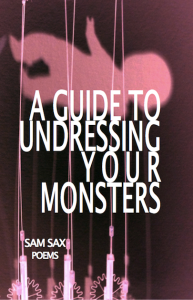46 pages, $12
Review by Yanyi Luo
A Guide to Undressing Your Monsters is a book of bridges. Within, tiny machines are drawn between self as self, self as lover, self as monster. Contrary to the title, no monsters are laid bare for examination. Rather, they are pressed between sections, folk and mythic characters metamorphosed through the speakers of Sax’s three-headed introductory triptychs, all titled “Bestiary”:
charybdis—
when i suck in / i make deadly / whirlpools / ask anyone
who’s managed / to climb out / alive
Sax’s narrators don’t inhale, they “suck in,” don’t escape, but “climb out / alive.” Many of Sax’s lines balance between connotations of sex and of violence, such as in poems like “Ribs,” where the narrator’s partner’s “whole body / smoked for ten hours” and the narrator reflects on eating him, and “Hunger Artist,” where another boy “gnaws through the sinew / strung up in my neck.” In the context of monsters, this blood-letting is almost expected, but the decadent frame points more to its own absurdity than masks the real feelings running off in these acts. These poems, rather than efface the boy in the monster, extract the monster to show plainly the boy.
In Guide, human and monster seem to blend. Something stirs between the border of boy and man and Sax is determined to write it. What results are poems whose subjects are about and in the midst of transformation. In “Putting on Emily Dickinson’s Clothes,” Sax reminds us that “you can’t take on / her voice without also taking her hands and throat,” guiding the metaphor of clothes somewhere to a bodily and possibly violent place. To arrive at those ending lines, Sax uses subtle assonance (an apt choice for a former slam champion) to stitch together thoughts around hymns swaying still hips and Dickinson’s clothes as actual body, a body as “thin pale eucharist.” For other poems, the transformation lies between the poems’ own content, such as in “Monster Country,” which connects the capitalistic “petroleum & coffee beans” with a chilling closet where “i trapped a terrified / girl in with my two good hands.”
It’s not that every bridge makes more monster from human. The sublimely titled “Butthole” brings blunt joy and beauty to address its titular subject—
how when you bleed you’re always trying to tell me
something. praise you, tiny gymnast, beastwith a breathing halo, gold band that weds my strange
body to this strange strange earth
The undulated praise makes the image of a bleeding hole much more noticeable. I’m not sure where to place the frame: how much do I, too, believe with this speaker’s exuberance? As I read on, the mythology of masculinity became as strong as any one of these monsters’. Instead of choosing, perhaps I was to take both positions of excitement and disgust.
Sax is searching for an invisible myth of manhood, one that aligns boy to man, man to man. He lines his trail with the poems like “Folktale,” where when men make love in an old Ukraine, they also make bread
the moral of this story is that for someone who has no bread,
no house, and no love, rubbing against a rich old man aint
that bad.
The crossings that he discovers are not always pretty, but lines like these are why Sax’s poems are like little machines. They are not merely conveyors, but translators and decorators of coming-of-age and sexual transgression, bridges that are often ugly and even violent. To get where he wants to go, Sax makes pretty on his own.
***
Yanyi Luo is a writer based in Brooklyn. She is a recipient of the 2015 Poet House Emerging Poets Fellowship. Her work has previously appeared in [PANK].
![[PANK]](http://pankmagazine.com/wp-content/themes/pank/assets/images/pank-logo-large.png)

